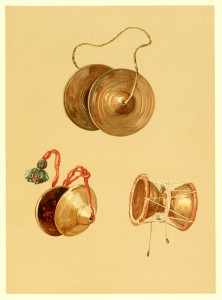TALA. JALRA. BUDBUDIKA.
METAL cymbals of all kinds are used as accompaniments to nati\’e
music. Farther North we find them chiefly in connection with
music of a religious character, but in the South their use is
universal. The larger kinds, called Jhanj, are much like the ordinary
Turkish cvmbals and are used in the Nahabet, and in company with the
Tala, or gong, in the wild temple music. The chief use made of all
cymbals is to mark the time. The two small kinds of cymbals here drawn
are peculiar to Indian music. The Jalra — shown uppermost in the
plate — are made in proportion a good deal thicker than the larger cymbals,
and they are played so as to produce a ringing sound, somewhat like
that of a trembling electric bell ; they are usually connected by a cord passed
through their centres.
The cup-shaped cymbals to the left of the plate are called
Tala, and are so made that their edges only are struck.
The Budbudika — shown on the right of the plate — is a small hand-drum from
three to six inches in length, used by snake charmers, mendicants, &c. In
shape it resembles an hour-glass, and in the centre a string is attached having a
small ball of leather or cork at the end. When shaken in the hand the striker
at the end of the string alternately touches each head.
A drum, somewhat similar in shape, called Edaka or Dudi, is common
in Coorg. It is of metal, and about 1 foot in length and 8 inches in diameter;
one end is beaten by a soft drumstick, the other by hand, like the dhol.

